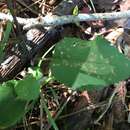Comments
provided by eFloras
Eurybia mirabilis is infrequent throughout its range. It has been reported for Alabama and Georgia but no specimens were seen. Such reports may be based on specimens of E. jonesiae identified as Aster commixtus. Both species have been so identified.
- license
- cc-by-nc-sa-3.0
- copyright
- Missouri Botanical Garden, 4344 Shaw Boulevard, St. Louis, MO, 63110 USA
Description
provided by eFloras
Plants 30–120 cm; not strongly colonial or in clumps, not or barely stipitate-glandular; rhizomes coarse, short, woody. Stems 1–3+, erect, slightly flexuous, simple, sparsely strigose proximally or glabrescent, densely strigose distally. Leaves basal and cauline, margins crenate-serrate, teeth mucronate, margins scabrous to strigoso-ciliate, apices acute to obtuse, ± acuminate, mucronate, abaxial faces scabrous (short strigose), adaxial ± densely strigose; basal and proximal cauline long-petiolate, petioles not to narrowly winged, sheathing, blades ovate, 50–200 × 30–120 mm, bases shallowly cordate to rounded; cauline shortly, broadly winged-petiolate to subpetiolate or sessile, ovate or elliptic to lanceolate or oblanceolate, 13–122 × 6–55 mm, gradually reduced distally, bases auriculate, not clasping, or cuneate to winged-attenuate; distal (arrays) sessile, obovate or oblong to lanceolate, 10–32 × 4–10 mm, bases rounded to attenuate, apices obtuse to rounded or acute. Heads 3–10+ in loose, flat-topped, corymbiform arrays. Peduncles densely strigose, sometimes sparsely stipitate-glandular distally; bracts 0–2, broad, densely strigose. Involucres campanulate, 7–12 mm, shorter than pappi. Phyllaries 46–75(–90) in 5–7 series, oblong-lanceolate (outer) to linear-lanceolate (inner), strongly unequal, membranous, bases indurate, rounded (outer), green zones in distal 1 / 3 – 1 / 2 foliaceous (outer) or 0 (innermost), margins hyaline, narrowly scarious, erose, ciliate, apices ± squarrose or reflexed, obtuse to acute and mucronulate (outer) or acuminate (inner), faces strigoso-villous to strigillose, eglandular. Ray florets (7–)16–20(–30); corollas white to lavender, 10–15 × 1.4–2.1 mm. Disc florets 20–40; corollas pale yellow, becoming purplish-tinged on lobes, funnelform, slightly ampliate, 6–7.5 mm, tubes longer than throats, lobes spreading, lanceolate, 1–1.5 mm. Cypselae reddish brown to brown, fusiform, compressed, 3–4 mm, ribs 7–12, faces sparsely strigillose; pappi of cinnamon (apically clavate) bristles, equaling disc corollas. 2n = 18.
- license
- cc-by-nc-sa-3.0
- copyright
- Missouri Botanical Garden, 4344 Shaw Boulevard, St. Louis, MO, 63110 USA
Synonym
provided by eFloras
Aster mirabilis Torrey & A. Gray, Fl. N. Amer. 2: 165. 1841
- license
- cc-by-nc-sa-3.0
- copyright
- Missouri Botanical Garden, 4344 Shaw Boulevard, St. Louis, MO, 63110 USA
Eurybia mirabilis: Brief Summary
provided by wikipedia EN
Eurybia mirabilis, commonly known as the bouquet aster or dwarf aster, is an herbaceous perennial in the family Asteraceae. It is endemic to the lower Piedmont of North Carolina and South Carolina in the southeastern United States. Within this small range it is found only infrequently, making it of conservation concern. The species is now largely confined to inaccessible bluffs due to the conversion of other habitats to farmland. It typically grows in deciduous or mixed deciduous woods, as well as on slopes or alluvial plains. Basic to neutral soils are usually preferred. Its flower heads emerge in the late summer to early fall and show white to lavender rays with pale yellow centres sometimes tinged with purple.
- license
- cc-by-sa-3.0
- copyright
- Wikipedia authors and editors

